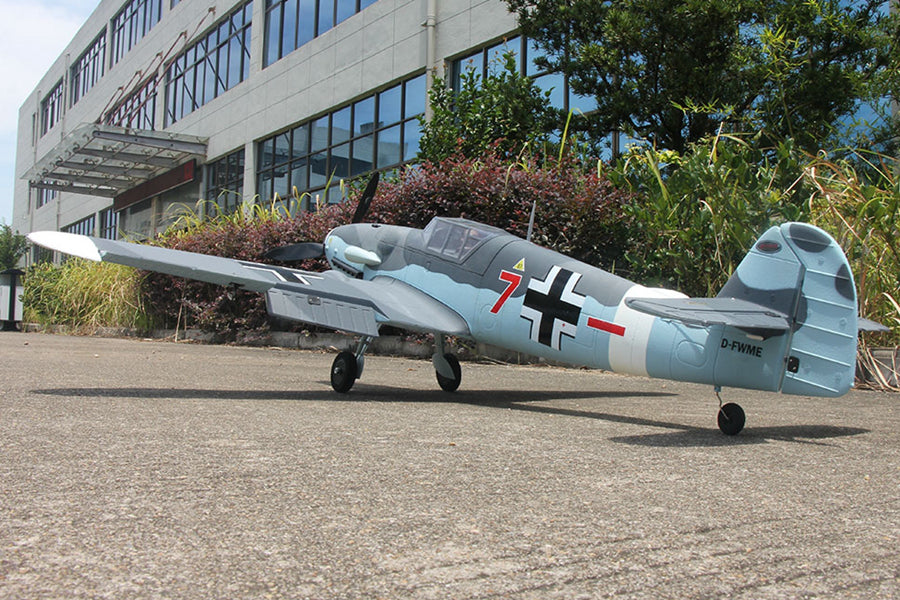When it comes to flying RC airplanes, especially warbirds like the Dynam Messerschmitt BF-109 V2 4S, one factor that can greatly enhance your flying experience is proper balancing. Balancing an RC airplane is a critical step in ensuring smooth and stable flights, and it’s not just a trivial task—it’s essential for safe, controlled, and enjoyable flying. In this article, I’ll dive into why balancing an RC airplane is crucial, how it affects stability, and how the Dynam Messerschmitt BF-109 V2 stands as a perfect example of how balance plays a role in performance.
I’ve personally flown the Dynam Messerschmitt BF-109 V2 4S RC Warbird Plane, and let me tell you—getting the balance right is a game-changer. But before we get into my personal experience, let's break down the science behind airplane balance and why it impacts flight stability.
Understanding the Importance of Balance in RC Airplanes
In simple terms, an airplane’s balance (also known as its center of gravity or CG) refers to the distribution of weight within the aircraft. For RC planes, this is crucial. If the plane’s CG is too far forward or backward, it will affect the plane's flight performance.
Why Is Balancing So Important?
Flight Stability: A balanced plane is less likely to pitch uncontrollably. If the CG is too far forward (nose-heavy), the plane will have a tendency to dive and require more elevator input to maintain level flight. If it's too far back (tail-heavy), the plane will become unstable, potentially leading to a loss of control.
Control and Maneuverability: A well-balanced plane responds better to control inputs, making maneuvers like turns, loops, and rolls smoother and more predictable. Unbalanced planes tend to be sluggish or overly sensitive, which can make the flying experience frustrating or unsafe.
Safety: Flying an unbalanced plane can be dangerous, especially with higher-speed models like the Dynam Messerschmitt BF-109 V2 radio control warbirds. Proper balance ensures the plane responds predictably to your inputs, which is vital when flying at high speeds or in challenging conditions.
How Does Balancing Affect the Dynam Messerschmitt BF-109 V2 4S?
The Dynam Messerschmitt BF-109 V2 4S is a powerful 1300mm wingspan warbird, and while it’s designed for stability, the importance of proper balance can’t be overstated. This RC plane is a scale model of the iconic WWII German fighter, and its performance mirrors the real-life aircraft’s agility and speed. With features like flaps, a high-speed motor, and a 4S battery setup, proper balancing ensures that the plane behaves as expected in various flight conditions.
Features of the Dynam Messerschmitt BF-109 V2 4S
- Wingspan: 1300mm
- Flaps: For better slow-speed control and easier landings
- Powerful 4S Brushless Motor: Provides impressive speed and maneuverability
- Aerodynamic Design: Respects the scale of the original BF-109, providing an authentic look and feel
- Ready-to-Fly (RTF) Setup: Includes everything you need to get airborne quickly
- Landing Gear: Retractable, adding realism to the flight experience
How Balance Improves the Performance of the BF-109 V2
When I first received the Dynam Messerschmitt BF-109 V2, I was eager to get it airborne. But, before I did, I made sure to carefully adjust the CG according to the manufacturer’s recommendations. By ensuring the CG was right around the specified 70-75mm from the leading edge of the wing (depending on your flying style), I was able to achieve optimal performance.
- Balanced Flight: With the proper CG, the plane flew straight and true, even at full throttle. The plane responded smoothly to control inputs, and I felt in control at all times.
- Smooth Loops and Rolls: The BF-109 V2’s flight characteristics are incredibly sharp when balanced properly. During aerobatic maneuvers like loops and rolls, the plane remained predictable and stable.
- Stable in Crosswinds: With the correct balance, the plane held steady in light crosswinds, allowing for more relaxed takeoffs and landings.
How to Balance an RC Airplane: A Step-by-Step Guide
Balancing an RC airplane like the Dynam Messerschmitt BF-109 V2 is a straightforward process, but it requires attention to detail. Here’s a general guide to help you get started.
1. Determine the Manufacturer’s Recommended CG
Every RC airplane, including the Dynam Messerschmitt BF-109 V2, comes with a recommended CG location. This is usually provided in the manual. The CG is typically measured from the leading edge of the wing.
2. Check Your Aircraft’s Weight Distribution
Before you even think about balancing, make sure all components are properly installed. This includes the motor, battery, receiver, servos, and any other accessories. Even slight changes in component placement can affect the balance.
3. Perform a Balance Test
Place your plane on a balancing tool or simply rest it on your fingers at the CG location. If the plane tips nose-down, it’s nose-heavy, and you need to move the battery or other components backward. If it tips tail-down, it’s tail-heavy, and you’ll need to shift components forward.
4. Make Adjustments
To move the CG forward or backward, adjust the placement of your battery or other components. For the BF-109 V2, I found that moving the battery just slightly forward made a noticeable difference in the handling and stability.
5. Recheck the Balance
After making adjustments, perform the balance test again. Repeat this process until the plane is perfectly balanced according to the manufacturer’s specifications.
Common FAQs About Balancing RC Airplanes
Q1: What happens if my plane is nose-heavy or tail-heavy?
A nose-heavy plane will be more difficult to control, especially during turns or at slow speeds. It will tend to dive and require more elevator input to maintain level flight. A tail-heavy plane will be unstable and might even pitch upwards uncontrollably.
Q2: How do I know if my RC plane is properly balanced?
You’ll know your RC plane is balanced correctly when it flies smoothly, responds well to control inputs, and maintains stable flight throughout various maneuvers. If you notice that the plane is difficult to control or behaves erratically, it may need balancing adjustments.
Q3: Can I balance my RC plane with the battery installed?
Yes, the battery is one of the most critical components in determining balance, so make sure it’s installed in the plane when you perform the balance test.
Q4: How often should I check my RC plane’s balance?
It’s a good practice to check the balance each time you install a new battery or make significant changes to the aircraft’s setup (e.g., adding new components). Frequent checks ensure optimal flight performance and safety.
Conclusion: The Importance of Balance in RC Airplanes
Balancing your RC airplane is more than just a precaution—it’s essential for a smooth, safe, and enjoyable flying experience. The Dynam Messerschmitt BF-109 V2 4S RC Warbird Plane is a perfect example of how balancing can directly impact the performance and stability of your aircraft. When balanced properly, the BF-109 V2 flies like a dream, with smooth turns, stable flight, and easy control even during more demanding maneuvers.
Whether you're a seasoned RC pilot or just getting started, taking the time to balance your aircraft will make a noticeable difference in your flight experience. So, before you take off on your next flight, be sure to check your airplane’s balance—your RC plane’s performance and your enjoyment will thank you!










